#AgTech Jobs
Explore tagged Tumblr posts
Text
Support Cutting-Edge AgTech: Technical Assistant Opportunity at NUST! - March 2025
The National University of Science and Technology (NUST) is seeking a motivated and hands-on Technical Assistant to join their Department of Agricultural Information Technology! If you have a passion for both agriculture and technology and are looking for a practical role in a dynamic academic setting, this is a great opportunity. About the National University of Science and Technology: NUST is…

View On WordPress
#Agricultural Information Technology#Agriculture Jobs#AgTech Jobs#books#Bulawayo Jobs#Computer Studies Jobs#Field Work#food#Hot Zimbabwe Jobs#IoT#IT Jobs#news#NUST Jobs#sports#Technical Assistant Jobs#technology#University Jobs
1 note
·
View note
Text
Funding: The HudsonAlpha AgTech Accelerator
The HudsonAlpha AgTech Accelerator is accepting applications from startups headquartered anywhere in the world that are working at the forefront of agriculture innovation. Selected startups will receive a $100,000 USD investment and access to global network of investors. Find more details here Deadline 16 June 2024 Also read: Consultancy: Consultants at CORAF Please follow us on X , LinkedIn ,…

View On WordPress
0 notes
Text
‘We thought we lived in Tuscany’: Hizbollah strikes ravage Israel’s north - FinancialTimes
The fighting has forced the largest evacuation of a region since Israel was founded more than 70 years ago.[...]
Many residents now wonder whether they will be able to return to an area that, in nearly two decades of relative calm since the last full-blown war between Israel and Iran-backed Hizbollah, had been part of a push to attract start-ups and other businesses to Israel’s under-developed periphery.
“For the last 17 years we thought we lived in Tuscany,” said Zeevi. “But when missiles started shooting from Lebanon, all of a sudden we realised that with all due respect to the start-ups, the innovation, climate tech, food tech, agtech, we live in the fucking Middle East. And we had forgotten about this.”[...]
Before the hostilities began, Kiryat Shmona was a city of about 24,000 people. Now it is a ghost town: traffic lights blink permanently orange; almost all businesses are closed; roads to the border are blocked by checkpoints. Locals say only 2,000 to 3,000 people remain — a mixture of essential workers and a small number of residents who refused to leave.[...]
[The] past 10 months have already taken a heavy toll on the region’s businesses. Zeevi, who before the war was general manager of the innovation hub at the Margalit Startup City in Kiryat Shmona, estimated that about 30 per cent of start-ups in the eastern Galilee had closed since the start of the war.
“It’s so frustrating, because we built something tremendous. People came from all over the world to see how in a very rural area you can create an ecosystem that develops start-ups and creates high-salary jobs,” he said.
In the family-run Oved’s Kabab in Kiryat Shmona, one of only a handful of businesses still open in the city, Tomer Oved said the restaurant was now running on a volunteer basis to help provide food for emergency personnel and incoming soldiers.
“We don’t care about business — it’s gone down by 55 per cent [since the start of the war]["][...]
Even before the latest surge in tensions, Hizbollah’s strikes had become an unprecedented strategic challenge for Israel, with the “war of attrition” in the north testing public patience to breaking point and heaping pressure on the government to respond.[...]
For now, most evacuees say the security situation remains too dangerous for them to return.
3 Aug 24
185 notes
·
View notes
Text
Financial Economics
By. Jacinda Thomas, Masters of Science in Wealth Management
Good Morning,
One of the first things I had to learn as a world class wealth manager was financial economics. Let's dive right in.
First we will break down the meaning of each individual word.
Financial: the study of finance; let's define finance: money or other liquid resources of a government, business, group, or individual
Economics: a social science concerned chiefly with description and analysis of the production, distribution, and consumption of goods and services
There were also other definitions as well.
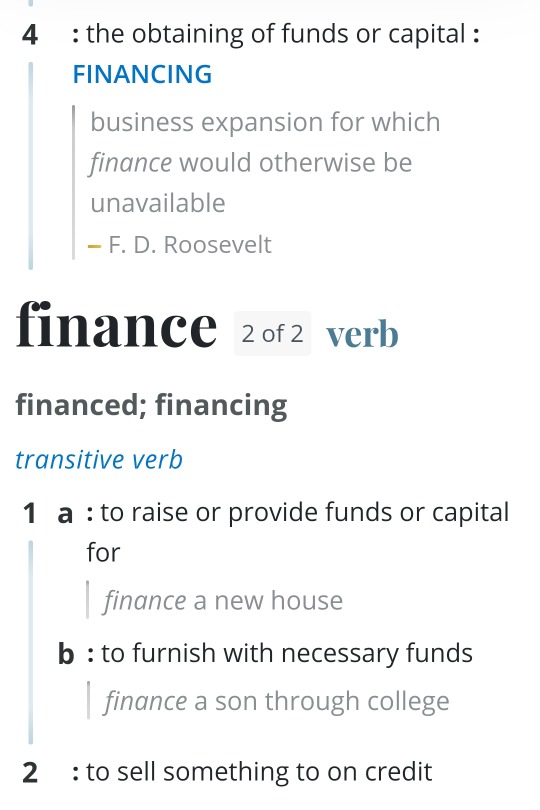
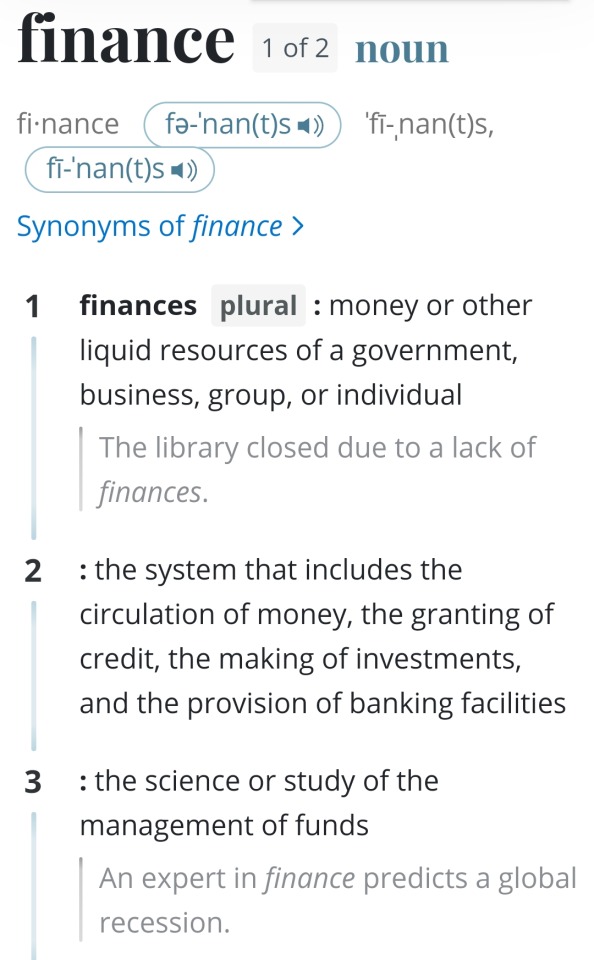

Now let's think about it: the economy is the revolving circulation of goods or services. And finance is simply money... so it's safe to say that financial economics is money of the circulation of goods and services.
This makes sense. As an ultra high net worth wealth manager, it's important to have a clear understanding of the circulatory money activity of goods and services.
This is one of the things that makes me such a great ultra high net worth wealth manager and advisor. As a person from a family of entrepreneurs I took a keen interest in how business is run from a very, very early age. As mentioned in my opening essay, throughout the last 16 years I've super deep dived into industries of all sorts: autos, mechanics, cars, fashion, retail, style grooming, software engineering, web development, apps, servers, computers, design, restaurants, food, logistics, warehousing, transportation, logistics, shipping/receiving, farming, agriculture, agtech, vertical farming, energy, wind, oil, pellet, real estate, construction, interior design, development, commercial, industrial, residential, art, music, touring, music production, education, teaching, higher learning, politics, government, religion, philanthropy, non-profit, finance products. With the latest being crypto, blockchain, and web3... I'm sure there are a few things I didn't mention, but overall these are few of the fields that I've had genuine authentic non-manufactured interest in. Which is key, genuine interest is rare.
Extremely thoroughbred in regards to understanding how the world works. Which will make me one of the most valuable and highly sought after high net worth wealth managers in the world.
Even the pastors need a pastor.
I understand the economy, the intricacies of how it interacts. And I'm continuously learning in natural ways.

We're never in a hurry, it's important that the table is set properly.
Okay so now let's dive deeper into financial economics.
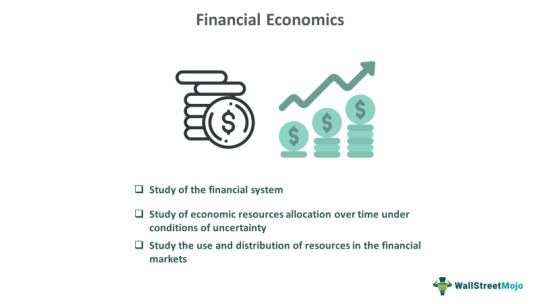
Our overall assumption just from defining the words is in the ballpark of this definition. The study of the financial system. The study of economic resources allocation over time under conditions of uncertainty. Yes this makes sense. The study of the use and distribution of resources in the financial markets.
Within a semester class we will learn much more to be able to adequately assist our clients and/or firms.
The Canadian lecture on financial economics adds a nice global perspective to our understanding.
The Financial Appetite blog does a lovely job of explaining this. Learn more here: https://www.thefinancialappetite.com/blog/what-is-financial-economics

What Is Financial Economics?
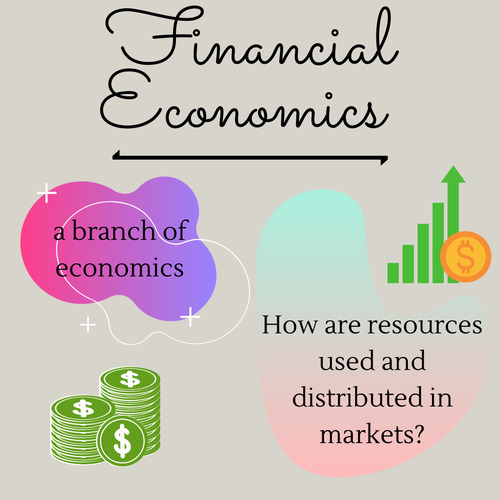
Financial economics is a branch of economics that analyzes how resources are used and distributed in markets. In general, it is the study of choices consumers, business managers, and government officials make to achieve their goals considering that they have limited or scarce resources. Financial decisions will frequently have to take into consideration future events, which can be related to individual stocks, portfolios, or the market as a whole. Financial economics differs from the other branches of economics because it pays particular attention to monetary activities. This branch of economics analyzes how inflation, depression, deflation, recession, prices, and other financial variables impact one another. It applies economic principles to financial markets, corporations, banks, and central banking policies, and uses economic theory to evaluate how time, risk, opportunity costs, and information can produce incentives for a particular decision. Financial economics plays an important role in making investment decisions, identifying risks, and valuing securities and assets.
What a wonderful break down. Let's see what Investopedia has to say.
Financial Economics
What Is Financial Economics?
Financial economics is a branch of economics that analyzes the use and distribution of resources in markets. Financial decisions must often take into account future events, whether those be related to individual stocks, portfolios, or the market as a whole.
KEY TAKEAWAYS
Financial economics analyzes the use and distribution of resources in markets.
It employs economic theory to evaluate how time, risk, opportunity costs, and information can create incentives or disincentives for a particular decision.
Financial economics often involves the creation of sophisticated models to test the variables affecting a particular decision.
How Financial Economics Works
Making financial decisions is not always a straightforward process. Time, risk (uncertainty), opportunity costs, and information can create incentives or disincentives. Financial economics employs economic theory to evaluate how certain things impact decision making, providing investors with the instruments to make the right calls.
Financial economics usually involves the creation of sophisticated models to test the variables affecting a particular decision. Often, these models assume that individuals or institutions making decisions act rationally, though this is not necessarily the case. The irrational behavior of parties has to be taken into account in financial economics as a potential risk factor.
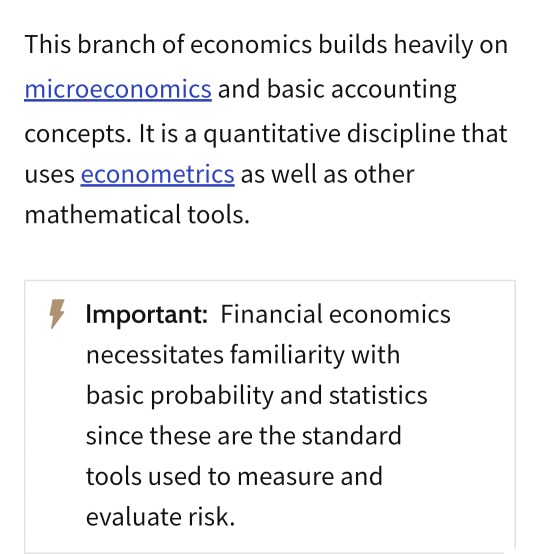
Investopedia compares it to traditional economics.
Financial Economics vs. Traditional Economics
Traditional economics focuses on exchanges in which money is one—but only one—of the items traded. In contrast, financial economics concentrates on exchanges in which money of one type or another is likely to appear on both sides of a trade.
The financial economist can be distinguished from traditional economists by their focus on monetary activities in which time, uncertainty, options and information play roles.
Financial Economics Methods
There are many angles to the concept of financial economics. Two of the most prominent are:
Discounting
Decision making over time recognizes the fact that the value of $1 in 10 years' time is less than the value of $1 now. Therefore, the $1 at 10 years must be discounted to allow for risk, inflation, and the simple fact that it is in the future. Failure to discount appropriately can lead to problems, such as underfunded pension schemes.
Risk Management and Diversification
Advertisements for stock market-based financial products must remind potential buyers that the value of investments may fall as well as rise.
Financial institutions are always looking for ways of insuring, or hedging, this risk. It is sometimes possible to hold two highly risky assets but for the overall risk to be low: if share A only performs badly when share B performs well (and vice versa) then the two shares perform a perfect hedge.
An important part of finance is working out the total risk of a portfolio of risky assets, since the total risk may be less than the risk of the individual components.
Let's look at one more source to understand Financial Economics. This time we will view a video:
youtube
Take the day to review the materials above. And welcome to Financial Economics.
Jacinda T.Thomas
#jacindathomas #financialeconomics #wealthmanagement
4 notes
·
View notes
Text
other than the fact that the university only pays wages once a month, I'd be over the moon to get that job at the agtech college
1 note
·
View note
Text
GTI Visa: A Comprehensive Guide to the Global Talent Independent Visa

In today’s fast-paced world, skilled professionals are in high demand across various industries, and countries like Australia are actively seeking global talent. The GTI visa (Global Talent Visa) offers an excellent opportunity for highly skilled individuals to live and work in Australia, paving the way for incredible professional and personal growth. This visa, officially known as the Global Talent Independent Visa, is designed for exceptional achievers in fields such as technology, engineering, arts, and academia.
What is the GTI Visa?
The Global Talent Independent Visa (subclass 858) is a streamlined visa pathway that allows highly talented individuals to secure permanent residency in Australia. It caters to individuals recognized globally for their achievements in target sectors. With this visa, applicants can benefit from priority processing, simplified application requirements, and access to one of the world’s most dynamic economies.
Benefits of the GTI Visa
Permanent Residency: The GTI visa grants you permanent residency, allowing you to live, work, and study in Australia indefinitely.
Work Opportunities: Access a thriving job market, particularly in the target sectors identified by the Australian government.
Family Inclusion: Include eligible family members in your visa application.
No Sponsorship Needed: Unlike other visas, you don’t need a job offer or sponsorship to apply for the GTI visa.
Path to Citizenship: Permanent residency is the first step toward becoming an Australian citizen.
Eligibility Criteria
To qualify for the GTI visa, you must:
Have an international reputation in one of the target sectors, such as FinTech, AgTech, advanced manufacturing, or medical technology.
Be nominated by a recognized Australian organization or individual.
Prove that you can contribute significantly to Australia’s economy, society, or culture.
Application Process
Expression of Interest (EOI): Submit an EOI to the Department of Home Affairs, showcasing your expertise and achievements.
Receive an Invitation: If your EOI is successful, you’ll receive an invitation to apply for the visa.
Lodge Your Application: Complete the visa application, including all required documents such as nomination evidence and proof of achievements.
Visa Grant: Upon approval, you’ll receive permanent residency status.
Why Choose the GTI Visa?
The Global Talent Independent Visa is an ideal choice for individuals looking to maximize their career potential while enjoying a high quality of life in Australia. Its flexibility, combined with the opportunity to work in cutting-edge industries, makes it one of the most sought-after visa options.
Conclusion
The GTI visa provides a gateway to a brighter future for global talent in various sectors. Whether you’re a tech innovator, an academic leader, or a creative artist, this visa ensures a streamlined process to secure permanent residency in Australia. Explore the opportunities available through the Global Talent Independent Visa and take the first step toward an extraordinary career and lifestyle in one of the world’s most dynamic countries.
0 notes
Text
Brent Frei: TerraClear’s Revolutionizing and Innovative Rock-Picking Solutions with Automated Agriculture
Agricultural Robotics, Precision Agriculture, or Smart Farming are also known as Automated Agriculture. This type of agriculture makes use of the advanced technological innovations of the modern era. An AgTech entity may use some of the following tools such as – Robots, Sensors, Data Analytics, Artificial Intelligence (AI), Drones, Global Positioning Systems (GPS), Biotechnology, Vertical Farming, Automation, Irrigation, Remote Monitoring, Smart Greenhouses, and many more. These technological tools used in agriculture are beneficial to farmers in sustainably maintaining, operating, monitoring, and controlling the efficiency, precision, and profitability of how they grow and harvest their crops.
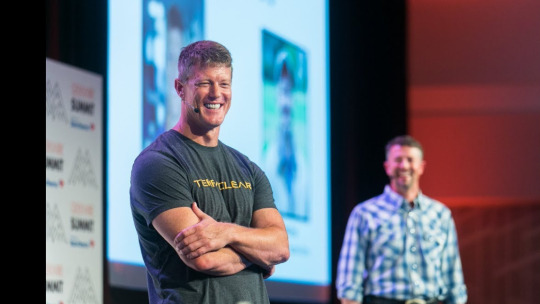
Automated Agriculture can combat many environmental challenges and help reduce the overall detrimental impacts that negatively affect the ecosystem and biodiversity. Automation can decrease the use and need for human labor and can efficiently and seamlessly improve operations and processes. It is cost-effective and a good investment by farmers which would help provide good, healthy, and improved yield in quality and quantity.
Many businesses, organizations, startup programs, and social enterprises adopt initiatives and strategies to be sustainable in their works and efforts in today’s world. Moving towards a bright future where everyone can live together harmoniously, safely, comfortably, and healthily, on Earth. Many technological innovations have been created for many reasons and purposes as solutions in combatting many challenges, and they are used today to improve our daily lives and routines for the better. One such AgTech innovation that has been created to help farmers manage and efficiently improve their fields is ‘Rock-Picking’.
Rock-picking is a process, practice, and strategy by farmers to remove rocks and large stones from the ground’s surface or deep underground in agricultural fields. This helps in better planting, cultivating, and harvesting crops in smoother and unobstructed fields. Rock-picking by physical human labor can be quite a tedious and nerve-racking job, from being bent over in fields and physically breaking down and lifting rocks. This can be quite hazardous and hence the use of automated agriculture helps tremendously. Therefore in this article, we will talk about one such company – TerraClear, founded and led by CEO – Brent Frei. TerraClear aims to provide end-to-end Rock-Picking solutions that would help farmers with their rock problems.
About Co-Founder and CEO of TerraClear – Brent Frei:
The Co-founder and Chief Executive Officer at TerraClear is Brent Frei. The founder holds a Bachelor’s Degree in Arts and Engineering from Dartmouth College, after which he soon started his career working in several positions and roles in various reputable companies, such as – Design Engineer at Motorola and Programmer Analyst at Microsoft. After this, Brent was inspired to begin his entrepreneurial journey of finding and building his own companies and businesses from the ground up.
Hence Brent founded and led as CEO at Onyx Software, Executive Vice President at Intellectual Ventures, Founder at HarvestWest Investments LLC, Founder and Board Member at Smartsheet, and finally founded and became the Chief Executive Officer at TerraPlay in the year 2017. Having amassed full knowledge and learning about Farms, Brent set out to sustainably create and help farmers solve their problems in rock-picking through the integration of technology and agriculture.
About TerraClear:
TerraClear’s journey started in the year 2017 when its founder and CEO – Brent Frei recognized farmers struggling and having difficulties in maintaining and managing their fields due to the presence of large rocks and stones. Therefore, Brent came up with the idea to provide an end-to-end solution that requires the integration of technology and agriculture so that rock-picking can be made easy and efficient with smart farming practices.
“Picking rock is hard work. TerraClear makes it easy.”
The company was established in The United States of America and has its headquarters located at Bellevue, in Washington. Along with providing end-to-end solutions in rock-picking for farmers, TerraClear also uses technological tools such as – Machine Vision, Aerial Sensing, Advanced Robotics, and High-Accuracy GPS in their rock-picking innovations and services.
“Rock-picking is solved by an automated agricultural implementation that clears rocks out of fields to enable today’s farmers to focus on high-value production and management activities.” – TerraClear. TerraClear’s technologies use scans and sensors that provide the exact details through Rock Maps available and accessible through phones and tablets, in identifying the precise locations of the rocks and stones. This helps the TerraClear team in locating and using their Rock Picker machines to get the job done. Being recognized as a Leader in Ag Innovation, TerraClear won the Davidson Prize in 2023 from the Association of Equipment Manufacturers. Geek Wire and Idaho Technology Council have also recognized TerraClear for their efforts in sustainability and technological innovations in agricultural practices.
Visit More : https://thebusinessmagnate.com/brent-frei-terraclears-revolutionizing-and-innovative-rock-picking-solutions-with-automated-agriculture/
0 notes
Text
Power AgTech Learning: Technician/Senior Technician Opportunity at NUST! - March 2025
The National University of Science and Technology (NUST) is seeking a skilled and experienced Technician/Senior Technician to join their Department of Agricultural Information Technology within the Faculty of Agricultural Science and Technology! If you’re passionate about providing technical support and ensuring smooth operations in a dynamic academic environment, this is an excellent…

View On WordPress
#Agricultural Information Technology#AgTech Jobs#Bulawayo Jobs#Computer Science Jobs#Hardware Support#IT Jobs#Network Administration#NUST Jobs#Software Support#Technician Jobs#University Jobs
0 notes
Text
Useful Tips for Becoming a Successful Agriculture Investor
Agriculture investment refers to the allocation of financial resources, capital, or assets into various aspects of the agricultural sector with the expectation of generating a return on investment (ROI). This could mean investing monies in agriculture land for sale such as coconut land for sale in Sri Lanka, or other types of investments. It involves deploying funds in activities and projects related to agriculture for the purpose of profit, income generation, or long-term wealth creation. Agriculture investment can take many forms, including:
Farmland Acquisition: Purchasing agricultural land for the cultivation of crops or the raising of livestock. This can involve both large-scale and small-scale farming operations.
Infrastructure Development: Investing in the construction and improvement of infrastructure such as irrigation systems, roads, storage facilities, and processing plants to enhance agricultural productivity and efficiency.
Technological Advancements: Funding the development and adoption of agricultural technologies, such as precision agriculture, automation, and biotechnology, to improve crop yields and reduce operational costs.
Agribusiness Ventures: Investing in agribusinesses, such as food processing, distribution, and marketing, that are part of the agricultural value chain.
Research and Development: Supporting research initiatives related to agriculture to develop new crop varieties, pest-resistant strains, and sustainable farming practices.
Input Supply: Investing in the production and distribution of agricultural inputs like seeds, fertilisers, pesticides, and machinery.
Commodity Trading: Speculating on the future prices of agricultural commodities, such as grains, oilseeds, and livestock, through commodity markets or futures contracts.
Sustainable Agriculture: Funding practices and projects aimed at sustainable and environmentally responsible farming methods, which can include organic farming, agroforestry, and conservation efforts.
Rural Development: Supporting initiatives that improve the overall economic and social well-being of rural communities, often through investments in education, healthcare, and infrastructure.
Venture Capital and Start-ups: Investing in start-ups and companies focused on innovations in agriculture, such as vertical farming, aquaculture, or agricultural technology (AgTech).
Agriculture investment is important for food security, economic development, and job creation in many regions. However, it also comes with risks related to weather conditions, commodity price fluctuations, and market dynamics. Investors often conduct thorough research and risk assessments before committing their resources to agricultural ventures. Additionally, they may need to consider factors like government policies, environmental regulations, and social impacts on their investment decisions in the agricultural sector.
How to become a successful agriculture investor
Becoming a successful agriculture investor requires a combination of financial acumen, agricultural knowledge, and a strategic approach to investment. Here are some steps to help you become a successful agriculture investor:
Educate Yourself: Gain a strong understanding of the agricultural sector, including the different sub-sectors (crops, livestock, agribusiness, etc.). Stay updated on industry trends, market conditions, and emerging technologies.
Set Clear Investment Goals: Define your investment objectives, whether it is long-term wealth creation, income generation, or diversification of your investment portfolio.
Risk Assessment: Understand and assess the risks associated with agriculture investments, such as weather-related risks, market volatility, and regulatory changes, whether you are looking at land for sale or any other type of investment.
Develop a Diversified Portfolio: Diversify your investments across different agricultural sectors and geographic regions to spread risk.
Market Research: Conduct thorough market research to identify promising investment opportunities and potential demand for agricultural products.
Build a Network: Establish connections with farmers, agricultural experts, government agencies, and industry stakeholders who can provide insights and opportunities.
Financial Planning: Create a budget and financial plan that outlines your investment capital, expected returns, and cash flow requirements.
Select the Right Investment Type: Choose the type of agriculture investment that aligns with your goals, whether it is farmland, agribusiness ventures, or agricultural technology.
Due Diligence: Conduct comprehensive due diligence on potential investments, including assessing the quality of farmland, the financial health of agribusinesses, and the technology's potential for scalability and profitability.
Sustainable Practices: Consider investments in sustainable and environmentally responsible agriculture practices, as they are gaining importance in the industry.
Risk Management: Implement risk management strategies, such as insurance, to protect your investments from unforeseen events like natural disasters or crop failures.
Continuous Learning: Stay informed about changes in the agricultural industry and adapt your investment strategy accordingly.
Legal and Regulatory Compliance: Understand and comply with local, national, and international regulations and tax laws that may impact your agriculture investments.
Monitor and Adjust: Regularly review the performance of your investments and be prepared to make adjustments or exit underperforming ones.
Long-Term Perspective: Agriculture investments often require a long-term perspective, so be patient and avoid making impulsive decisions based on short-term market fluctuations.
Seek Professional Advice: Consult with financial advisors, agricultural experts, and legal professionals to ensure that your investments are structured and managed effectively.
Successful agriculture investment often involves a mix of financial expertise, industry knowledge, and a willingness to adapt to changing conditions. It is important to approach agriculture investment with a well-thought-out strategy, and to be prepared for both opportunities and challenges in this sector.
#Agriculture investment refers to the allocation of financial resources#capital#or assets into various aspects of the agricultural sector with the expectation of generating a return on investment (ROI). This could mean#or other types of investments. It involves deploying funds in activities and projects related to agriculture for the purpose of profit#income generation#or long-term wealth creation. Agriculture investment can take many forms#including:#●#Farmland Acquisition: Purchasing agricultural land for the cultivation of crops or the raising of livestock. This can involve both large-sc#Infrastructure Development: Investing in the construction and improvement of infrastructure such as irrigation systems#roads#storage facilities#and processing plants to enhance agricultural productivity and efficiency.#Technological Advancements: Funding the development and adoption of agricultural technologies#such as precision agriculture#automation#and biotechnology#to improve crop yields and reduce operational costs.#Agribusiness Ventures: Investing in agribusinesses#such as food processing#distribution#and marketing#that are part of the agricultural value chain.#Research and Development: Supporting research initiatives related to agriculture to develop new crop varieties#pest-resistant strains#and sustainable farming practices.#Input Supply: Investing in the production and distribution of agricultural inputs like seeds#fertilisers#pesticides#and machinery.
1 note
·
View note
Photo

Robots, AI and Tiny automated machines are invading the agriculture industry. Fewer chemicals, more efficient, more productive – where’s the downside? Click the link in our bio 👆or visit teenkidsnews.com to find out. #AI #robotics #solarenergy #jobs #farmers #automation #agtech https://www.instagram.com/p/BxAmWORlu1z/?igshid=48sda3b8oduu
0 notes
Text
Louis Lehot Discusses Technology Innovation with Delegation of Belarussian Human Rights
LOUIS LEHOT, a corporate and technology law partner with leading global law firm Foley & Lardner LLP in Silicon Valley, recently visited with a delegation of Belarussian human rights activists, including Mrs. Sviatlana Tsikhanouskaya, who ran in the 2020 Belarussian presidential election as the main opposition candidate. The group, which also included leading academics, entrepreneurs, investors, and thought leaders, convened in Silicon Valley to explore ways to create vibrant economic growth fueled by clusters of technology innovation.
In a wide-ranging and thorough conversation, the participants discussed the importance of academic freedom in universities, freedom of expression, the rule of law, principles of private property, intellectual property protection, statutes to allow for the creation and funding of business enterprise, the role of a sophisticated judiciary, industrial policy, and other principles of democratic societies. The attendees shared their experiences building companies in clusters of innovation around the world, where universities fostered research in technology and innovation, how pools of risk capital formed to fund new enterprises, and how freedom of movement, expression, and wealth creation fostered companies that could grow from the garage to the global stage.
Specifically, participants of the Silicon Valley consortium discussed the role of Stanford University, the University of California at Berkeley, and other leading academic institutions in creating technology and training generations of technologists. They explained the history of Silicon Valley, and how investors had congregated around the universities and raised funds to create an alternative asset class to fund risky new ventures, called “ venture capital.” As new companies raised funds, brought products to market, and disrupted industries, they went global. Larger pools of equity capital then became available at a lower cost. These companies went for stock exchange listings in the public markets and raised more equity capital. As they developed histories of good cash flow and well-valued assets, they became eligible for debt capital to further finance growth. Investment banks flocked to Silicon Valley, as did private equity investors for mature companies. The participants described how clusters of innovation had similarly developed in other markets such as Israel, Europe, and Asia.
Some key takeaways from the discussion included:
1. The importance of the government’s role in providing a system where the rule of law is predictable and incentivizes the creation of technology innovation.
2. How white papers can be used to drive discussion and develop consensus around key principles, goals, and priorities.
3. Using regulatory “sandboxes” to allow for development and experimentation within areas of technology innovation.
4. The key role the rise of the digital economy plays in technology innovation.
The importance of connecting entrepreneurs in the diaspora with the home country to bring back learning, capital, and innovation.
The importance of the empowerment of women.
Attorney advertising-prior results do not guarantee a similar outcome.
The opinions expressed here are my own and do not reflect those of Foley & Lardner LLP.
About the Author:
LOUIS LEHOT is an EMERGING GROWTH COMPANY, VENTURE CAPITAL, AND M&A LAWYER at FOLEY & LARDNER in Silicon Valley. Louis spends his time providing entrepreneurs, innovative companies, and investors with practical and commercial legal strategies and solutions at all stages of growth, from garage to global. He focuses his efforts on technology, digital health, life science, and clean energy innovation. Louis’s clients are public and private companies, financial sponsors, venture capitalists, investors, and investment banks, and he has helped hundreds of companies at formation, obtaining financing, solving governing challenges, going public, and buying and selling. LOUIS is PRAISED by clients, colleagues, and industry guides for his business acumen, legal expertise, and leadership in Silicon Valley.
Connect with LOUIS LEHOT:
Website: LOUIS LEHOT
Website: LOUIS LEHOT
LinkedIn: LOUIS LEHOT
Facebook: LOUIS LEHOT
Louis Lehot on Patch
Louis Lehot on Instagram
Louis Lehot on Youtube
Louis Lehot on Crunchbase
Louis Lehot on Muckrack
Louis Lehot Interview on Ideamensc
Louis Lehot on Data Driven Investor
Read the Articles written by LOUIS LEHOT:
LOUIS LEHOT- What to expect for seed and pre-seed stage financing in 2021
LOUIS LEHOT- A Brief Legal Guide To Buying And Selling Shares Of Private Company Stock
LOUIS LEHOT- The IPO Markets Are Changing, And So Is The Lock-up Agreement
LOUIS LEHOT- What are SPACs, and how they are different from IPOs?
LOUIS LEHOT- L2 Counsel Represents AgTech Leader FluroSat In Dagan Acquisition
LOUIS LEHOT- Considering Selling Your Company? Be Clear on Your Fiduciary Duties
LOUIS LEHOT- Incentivizing With Stock Options: What Your Startup Needs To Know About ISOs, NSOs And Other Parts Of The Alphabet Soup
LOUIS LEHOT- Ready To Sell Your Startup In 2021?
LOUIS LEHOT- The State Of The Acqui-Hire In 2021: The Good, The Bad, The Why And What’s Next
LOUIS LEHOT- Leaving Your Job? Don’t Forget Your Stock Options…
LOUIS LEHOT- A Short Primer for Startups on Local Labor and Employment Law Compliance
LOUIS LEHOT- How To Clean Up A Corporate Mess
LOUIS LEHOT- Calculating And Paying Delaware Franchise Taxes — Startups Need Not Panic
1 note
·
View note
Text
Job interview w the state agtech university on Tuesday okkkk
0 notes
Photo

University of Wyoming students! Join us at the job fair today and tomorrow and come learn about all the opportunities there are to join our rapidly growing team in 2017 and help us empower modern farmers everywhere! 👈 #uwyo #uwyobiz #uwyoreslife #uwyocampus #wyoming #laramie #business #startup #agtech #indoorfarming #modernfarming #jobs #307 (at University of Wyoming)
#307#uwyobiz#laramie#indoorfarming#startup#uwyocampus#modernfarming#jobs#wyoming#agtech#uwyoreslife#uwyo#business
2 notes
·
View notes
Photo
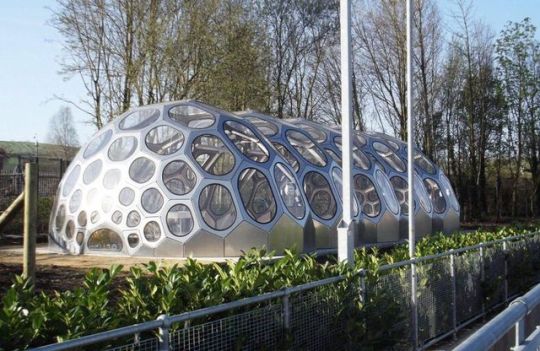
How "Plant" Is Designing The Future Of Food And Education
CONTENT SOURCED FROM FORBES
Karim Giscombe is one of those quiet revolutionaries. Meeting him in the exclusive Spring Place members club in Tribeca in NYC, he cuts an unassuming figure, stylish and low key. He speaks with a measured intensity, his eyes watching you to see if you’ve understood the full gravitas of what he is attempting to do.
This former Bank of America Merrill Lynch director (his LinkedIn Profile calls himself a ‘reformed capitalist’) has embarked via his new venture Plant on a crusade to feed the world (using the power of schools, technology and branding) and create a new category which he dubs ‘Agriculture as a Service.' When asked why he’s doing it, his response is simply, “Everybody’s gotta eat.”

Karim Giscombe
First some context: The global demand for food is rising exponentially and will reach all-time highs by 2050 as the population approaches 10 billion people - and agriculture is not prepared for that. There are many efforts underway aimed at potential solutions and Controlled Environment Agriculture (indoor farming as it most commonly labeled) is taking center stage because of the many benefits of this growing process. If the goal is to find the balance between resources and production, right now it seems clear that the future of food must be indoor, local, energy efficient and infinitely scalable.
The business of food is changing and forcing the incumbents to respond to the new dynamic. Amazon acquired Whole Foods, while in Europe Tesco and Carrefour have launched a NATO-style alliance to increase purchasing power, Dell Computer has partnered with vertical farm operator AeroFarms to better understand crop data, and Wendy’s recently announced plans to only purchase greenhouse grown tomatoes beginning in 2019. Other notable mentions include moves by industry leaders such as Tyson Foods, Bayer, Hormel, and Nestle.
Investment has also gained momentum seeing the opportunities, with names like SoftBank, Google Ventures, and KKR placing big bets on the future of agriculture. William Blair & Co. has dubbed it “the AgTech Revolution” and Goldman Sachs has said the growing market may be worth $240 billion by 2050.
Giscombe and the team at Plant are taking an innovative approach looking at under utilized land in and near city centers and applying cutting-edge technology to modernizing food production and distribution - while re-imagining public education at the same time. This first-of-its-kind Public/Private Partnership model is a combination of equally ambitious Infrastructure Development and Social Design projects that have the potential to change many narratives.
“Plant is a platform solution. A service provider operating high-tech greenhouses that can produce and deliver a wide range of fresh, post-organic fruits and vegetables at competitive price points, locally. We’re unconstrained by land availability in most geographies and even with a starting footprint of 6 million sq. ft. per market, we’re just scratching the surface. Solving the production problem is only a part of the challenge; there are numerous improvements needed to the supply-chain itself. This is our focus. It’s the holy grail of retail known as the “Last Mile” and this is where we believe we can have the most impact. This is what On-Demand Agriculture is all about. This is what consumers want. There is no reason to limit our thinking,” Giscombe states. "It’s about resources, balance, and most importantly- people. We believe in building systems for people, not around them.”
Plant’s operation is carbon neutral and more environmentally sustainable, using concentrated solar power and hydroponic systems to refine a process that already out-performs traditional agriculture. Nutrients are delivered through a treated water system and there is no use of agri-chemicals such as pesticides or insecticides and food safety measures control who and what enters facilities, reducing the risks of contamination and food-borne illness.
Proximity to urban centers makes it possible for them to optimize produce for quality and taste in lieu of shelf life and providing year-round access to fresh produce.
It's not just the hardware - but the software that’s taking the game to a whole new level. Giscombe says “It’s not widely understood that Big Data is now an integral part of agriculture and that the two will be inextricably connected going forward. When we tell people we’re in the data business there’s this look of confusion at first, but after a while they get it. To be the best at our core service business, we made the decision to partner with the best in component providers early on. One of our key partners is iUNU out of Seattle. Their crop management and analysis system LUNA, uses computer vision and artificial intelligence to monitor the health and progress of all crops under cultivation allowing us to detect growth down to the millimeter and create 3D models of plants to improve growing recipes — the light, water, temperature, and nutrients — with each new planting. In other words, we’re collecting and synthesizing a lot of data.”
What may be the most exciting element of the work Giscombe and his team are doing though, is Plant for Tomorrow, #P4TMRW, the not-for-profit research and development initiative the company has launched to collaborate with School Districts and educational institutions. Starting with middle-school grades, the initiative provides access to relevant and in-demand skills (technical and humanities-based) for more students at the peak of their developmental curiosity. There is no cost to the schools as the initiative has been designed to be self-sustaining.
Plant-operated commercial farms on district-owned land (up to 1 million sq. ft.) generate revenue from produce sold to distributors within the predetermined local service area. “It’s not really a solution if we can’t reach everybody. Outside of school, there’s still a community that needs to eat. Our produce makes its way to commercial and residential kitchens giving us greater reach and making a greater impact. We’re starting with Broward County Public Schools because this is home. They’re also the sixth-largest in the country, serving a highly diverse population,” Giscombe says.

The Plant4Tomorrow Prototype.
And what’s the secret sauce? “Design. We literally started with the design. We needed to create an experience that would grab our audience (the kids), while seamlessly integrating into the civic landscape and N55 made that possible,” Giscombe says, referring to the partnership with the Denmark-based group (architect Anne Romme, artist Ion Sørvin and engineer Anne Bagger) to create the eye-catching structures.
The Plant for Tomorrow mission is to foster lifelong learning for all, through active education transforming schools into more expansive learning hubs for the broader community. It’s a quadruple bottom-line idea in terms of producing social value and an economic development catalyst as the initiative also creates a significant number of jobs.
“One of our guiding principles at Broward County Public Schools is applied learning, where we seek to create opportunities for students to apply what they are learning to real-world scenarios. This innovative Public/Private Partnership with Plant for Tomorrow will deliver on this goal; giving our students a unique educational experience while addressing major agriculture/food issues. This partnership will also generate funding for in-school programs and ensure the sustainability of this initiative. This is a win for our students, it’s a win for public and private partners, and it’s a win for the environment.”
— Robert Runcie, Superintendent, Broward County Public Schools

Plantation Middle School, the site for the first Plant4Tomorrow.
Giscombe, a father himself, is passionate when he says “Our kids are far ahead of us when it comes to processing power, yet we continue to empower them to blindly follow old paths. In case you haven't heard, they’re hip to that- and have not-so-politely declined. Their voices today, sound a lot like we once did. And though we willingly set aside the aspirations of our youth, this generation won’t be silenced, and we couldn't if we tried. Everything is connected today, and how we engage our kid's factors into their view of what's next, and more importantly, what they choose to do about it.”
Now if you’re thinking this seems like an enormous undertaking all around, you’re right. To create the kind of runway necessary to commit to and see through what will take years to fully deploy, the company is partnering with leading boutique investment bank, B.C. Ziegler, to lead the issue of tax-exempt revenue bonds for the bulk of the financing across the U.S. markets in which the company is establishing operations.
The bonds are expected to be available in the market before year-end, with further international expansion on the cards, though the company is tight-lipped about which ones specifically. Plant and Plant for Tomorrow are also open to working with brands, especially those who have an interest in helping innovate across the food and education systems, to partner in scalable and sustainable ways.
Beyond the technology and the business opportunity, what gets Giscombe really energized is the potential for whole scale transformation of the social contract between people and their food. He speaks passionately about this new era.
“It’s a new relationship, plain and simple," he explains. "Around the world, social systems are failing, people aren’t interested in new rhetoric and instead opt for new approaches to old and new challenges. The new standard to which government, industry, and business at-large are being held accountable, is purpose. The new kids on the block are taking over the conversation, bringing new solutions to the table announcing a new paradigm; now we’re bringing the people to the table; through food."
"If it wasn’t a movement before, we’re taking responsibility for making it one."
#urban agriculture#urban farming#education#STEM#STEAM#food#food systems#vertical farm#greenhouse#double-size
43 notes
·
View notes
Text
Harness the Power of Data in Agriculture: Data Science Lecturer/Professor Opportunities at NUST! - March 2025
The National University of Science and Technology (NUST) is seeking passionate and experienced academics to join their Faculty of Agricultural Science and Technology as Lecturers/Senior Lecturers/Associate Professors in Agricultural Information Technology, specifically focusing on Data Science! If you’re excited about applying data-driven solutions to agricultural challenges, this is a fantastic…

View On WordPress
#Agricultural Information Technology#AgTech Jobs#Artificial Intelligence#Bioinformatics#Bulawayo Jobs#Data Science Jobs#Lecturer Jobs#Machine Learning#NUST Jobs#Precision Agriculture#Professor Jobs#Research Jobs#Teaching Jobs#University Jobs
0 notes
Text
The homegrown agriculture fund betting on a bumblebee disruptor
Israel-based Arugga has up to 20 pollination robots working in Costa’s glasshouse tomato crop in Guyra, NSW, to replace manual methods and bumblebees. Cultiv8 can invest in Australian and global companies, but Mr Nutt says the fund seeks to invest in technology that will be expanded in Australia to improve productivity, the supply chain or the consumer. “Being in the Southern Hemisphere, it means these global companies can trial their product all year around,” he said. “We’re being recognised for being clean and green, access to the Asian consumer. There are many advantages we can add to these businesses which means we can usually win the deal.” The National Farmers Federation says over 170,000 workers are needed to alleviate a chronic shortage of labour across Australia’s food supply chain, a key theme of the August Jobs and Skills summit and a factor behind rising food prices. Farmers are also confronting a range of biosecurity issues from the deadly varroa mite placing Australia’s bee industry in lockdown to the threat of foot-and-mouth disease. Interest in agtech is heating up after years of under-investment as venture capital funds and family offices seek sustainable and impact investments. Mr Nutt points to the latest AgFunder AgriFoodTech Investment Report which shows investors pumped more than $50 billion into the sector last year, up from $12 billion five years ago fuelled by the trend towards digitisation, a drive from consumers to know where their food is coming from, and businesses embracing sustainability. The fund’s other key investments are Australian rural connectivity company Zetifi; SOOS Technology, a company reversing the gender of chickens before they hatch to reduce the culling of male chicks; and bee-free honey producer MeliBio. Asparagopsis can cut the methane emissions in the form of burps and farts from livestock when added to their feed rations, Nic Walker Cultiv8 has also backed FutureFeed, born out of a collaboration between CSIRO, James Cook University and Meat & Livestock Australia to explore the use of seaweed to reduce livestock methane emissions. FutureFeed boasts seven licensees across Australia, New Zealand, the United States, Canada, and Europe and has received investment from Andrew Forrest’s Tattarang, Woolworths and GrainCorp. “The technology can reduce methane by up to 90 per cent and improve productivity by up to 10 per cent,” Mr Quigley said. “Instead of that energy converting into methane and being expelled by the mouth through breathing and belching, it transitions to either meat or in the case of dairy cattle, milk output.” Like the listed tech sector, agtech hasn’t been immune from the impact of rising interest rates on the amount of capital flowing to early-stage companies. The managers said their space hasn’t seen the same aggressive upside as the broader tech scene due to its nascent positioning, but noted significant pullbacks in valuation in the alternative protein and e-commerce sectors. “The more tangible investments and earlier stage, seed and series A… we haven’t seen a large pullback at all,” Mr Nutt said. Cultiv8 has linked with investment management business Fidante to launch the fund, whose parent Challenger is the cornerstone investor in the first raise. It will have a target size of $100 million and a gross return target of 20 per cent per a year over nine years. Mr Quigley and Mr Nutt are also partners in the Sparklabs Cultiv8 accelerator program which has supported 36 start-up companies. Source link Originally published at Melbourne News Vine
0 notes